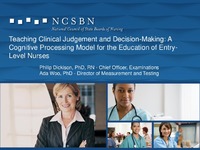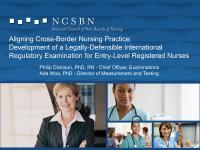| dc.contributor.author | Woo, Ada | en |
| dc.contributor.author | Dickison, Philip | en |
| dc.date.accessioned | 2016-07-13T11:06:02Z | |
| dc.date.available | 2016-07-13T11:06:02Z | |
| dc.date.issued | 2016-07-13 | |
| dc.identifier | INRC16P09 | |
| dc.identifier.uri | http://hdl.handle.net/10755/616166 | |
| dc.description | <p>Theme: Leading Global Research: Advancing Practice, Advocacy, and Policy</p> | en |
| dc.description.abstract | <p>Session presented on Monday, July 25, 2016:</p>
<p>In the United States, the landscape of healthcare has seen many changes in the past few decades. As an integral part of the healthcare team, nurses face many of the challenges associated with these changes. With over three million practitioners, nursing is the largest part of the healthcare workforce in the U.S. The increase in patient acuity, aging of the population and healthcare reform have all contributed to the heightened demand for nurses in all practice levels. In the Institute of Medicine (IOM) Future of Nursing report published in 2010, the IOM cited that nurses at all levels should practice at their full scope. As clinical judgement skills are a fundamental part of the healthcare profession, this suggested that entry-level nurses are expected to make sound clinical decisions just as their more experienced colleagues. In this proposed session, the authors will review existing models for classifying the nursing clinical judgment process and psychological research on decision-making (e.g., Benner, 2000; Harbison, 2001; Phaneuf, 2008; Saintsburg, Gibson & Pennington, 2011). Combining current nursing clinical judgment models and cognitive psychology literature on decision-making (e.g., Oppenheimer & Kelso, 2015), the authors propose an education framework for the instruction of nursing clinical judgment. In this proposed model, nursing clinical judgment is broken down by five procedural components: (1) cue recognition, (2) hypotheses generation, (3) hypotheses evaluation, (4) solution generation and taking action and (5) outcome evaluation. In addition to discussing each components of the proposed model, the authors will focus on the interactions between the clinical judgment process and contextual factors that may impact clinical judgments. These contextual factors may encompass the care environmental (e.g., resources, time constraints, distractions and task complexity), characteristics of the nurse (e.g., knowledge, experience and perceptions) and characteristics of the client (e.g., disease progression and family dynamics). This proposed nursing clinical judgment model is useful as a pedagogical tool in training entry-level nurses to make sound clinical decisions. It also serves as a tool for understanding how nurses make decisions in the clinical setting. The authors will conclude the session by applying the model to several clinical nursing scenarios that will illustrate how the model may be used for training of entry-level nurses.</p> | en |
| dc.format | Text-based Document | en |
| dc.language.iso | en | en |
| dc.subject | Nursing Clinical Judgment | en |
| dc.subject | Decision-Making | en |
| dc.subject | Entry-Level Nursing Practice | en |
| dc.title | Teaching clinical judgment and decision-making: A cognitive processing model for the education of entry-level nurses | en |
| dc.title.alternative | Teaching strategies: Encouraging critical thinking | en |
| dc.type | Presentation | en |
| dc.rights.holder | <p>
All rights reserved by the author(s) and/or publisher(s) listed in this item record unless relinquished in whole or part by a rights notation or a Creative Commons License present in this item record.
</p><p>
All permission requests should be directed accordingly and not to the Sigma Repository.
</p><p>
All submitting authors or publishers have affirmed that when using material in their work where they do not own copyright, they have obtained permission of the copyright holder prior to submission and the rights holder has been acknowledged as necessary.
</p> | en |
| dc.description.note | <p>Items submitted to a conference/event were evaluated/peer-reviewed at the time of abstract submission to the event. No other peer-review was provided prior to submission to the Henderson Repository.</p> | |
| dc.type.category | Full-text | en |
| dc.evidence.level | N/A | en |
| dc.research.approach | N/A | en |
| dc.contributor.department | Non-member | en |
| dc.author.details | Ada Woo and Philip Dickison, RN | en |
| dc.conference.name | 27th international Nursing Research Congress | en |
| dc.conference.host | Sigma Theta Tau International | en |
| dc.conference.location | Cape Town, South Africa | en |
| dc.date.conferenceyear | 2016 | |
| dc.contributor.affiliation | National Council of State Boards of Nursing, Chicago, Illinois, USA | en |
| dc.description.reviewtype | Abstract Review Only: Reviewed by Event Host | en |
| dc.description.acquisition | Proxy-submission | en |





